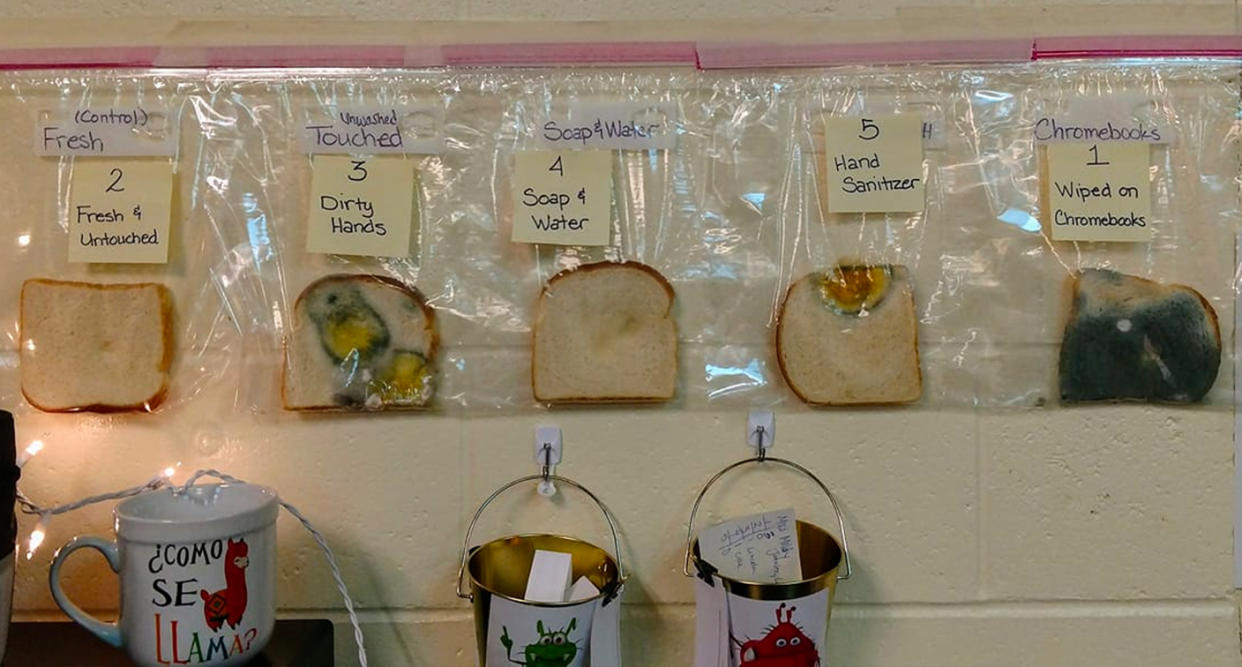This school science experiment will make you want to wash your hands: ‘So disgusting’

With cold and flu season upon us, a couple of elementary school teachers decided to try a hygiene science experiment that they hoped would encourage students to wash their hands and spread fewer germs. The results were eye-opening.
“We did a science project in class this last month as flu season was starting,” Jaralee Metcalf, a behavior specialist at Discovery Elementary School in Idaho Falls, Idaho, wrote in a Facebook post, which has since gone viral with more than 64K shares. “We took fresh bread and touched it. We did one slice untouched. One with unwashed hands. One with hand sanitizer. One with washed hands with warm water and soap. Then we decided to rub a piece on all our classroom Chromebooks,” adding that the school normally sanitizes their computers but didn’t for this experiment.
Each slice of plain white bread — which was taken from the same loaf on the same day — was placed and sealed in a freezer Ziploc bag. Due to preservatives, they waited three to four weeks for results and found that most of the bread slices were full of mold. “This is so DISGUSTING!!!” wrote Metcalf. But there were two exceptions: The bread that hadn’t been touched and the bread touched by hands washed with soap and water looked fine.
So how did students react when they saw the mostly moldy results?
“The kids were both shocked and enlightened!” Metcalf tells Yahoo Lifestyle. More importantly, the surprising science lesson has had a positive effect on student hygiene. “They have changed their hand washing habits,” she shares.
Carl P. Borchgrevink, PhD, director of the School of Hospitality Business and the John and Becky Duffey Faculty Fellow in Hospitality Business at Michigan State University, tells Yahoo Lifestyle that the experiment is a great idea. “I think this is a fabulous way of teaching students and adults the importance of hand washing. Typically, people do not see clear evidence of the germs they carry with them. This experiment provided excellent visual clues! It also informs the students about how research can be done.”
Metcalf, who described herself in her Facebook post as “somebody who is sick and tired of being sick and tired of being sick and tired” wanted students to understand why cleaning your hands is necessary. “Hand washing is important because the spread of illness is so high this time of year, especially among students and teachers,” she tells Yahoo Lifestyle. “I am so tired of bringing illness home to my family. I hope the kids not only continue to wash their hands, but I hope parents learn to keep their children home when they're sick after seeing how easily illness is spread through germs!”
Borchgrevink agrees, telling Yahoo Lifestyle, “Our hands are the perfect device for spreading germs and ingesting germs,” explaining that it’s easy to pick up bacteria that people don’t see “from the sink/faucets, from the door knob, and from any surface they touch thereafter, such as table top, counter top, railing, door knob, seat back, etc.” He adds, “Without thinking, we often bring our hands to our mouths to scratch, eat, etc., after having touched a surface, object, or animal that may be bacteria-laden, and by doing so may add some unwanted bacteria.”
Curious to try the bread experiment at home? Metcalf shared a link to C.S. Mott Children’s Hospital in Michigan, which shows how to do the hand hygiene science project.
The best way to keep hands clean
Most people — not just kids — aren’t doing a great job of properly washing their hands. A 2013 study of more than 3,700 people led by Borchgrevink found that only five percent of people are washing their hands well enough to actually kill germs after using the bathroom (and 10 percent didn’t wash their hands at all, with men being the worst offenders). The “best” way to kill germs, according to the Centers for Disease Control and Prevention (CDC), is to wet hands and then wash them using soap and warm or cold water (either is fine). Be sure to wash and scrub hands for 20 seconds, which is the equivalent of singing “Happy Birthday” twice.
“Make sure to wash between fingers, around and under nails, and if you can, up to or beyond your wrist,” says Borchgrevink.
If you don’t have access to soap and water, the CDC recommends using an alcohol-based hand sanitizer. Check the label to make sure it has at least 60 percent alcohol.
The other key factor to keeping hands clean: Dry them properly. Not doing so can increase the spread of bacteria, according to a 2010 study published in the journal Journal of Applied Microbiology. The study also found that using paper towels, rather than rubbing hands under a dryer, was the most effective way to dry hands while reducing bacteria.
Read more from Yahoo Lifestyle:
Over 2,000 Americans have already died from the flu this year — here's what you need to know
People are freeze-drying their pets after they die: ‘They don’t want to let go’
Follow us on Instagram, Facebook and Twitter for nonstop inspiration delivered fresh to your feed, every day.

